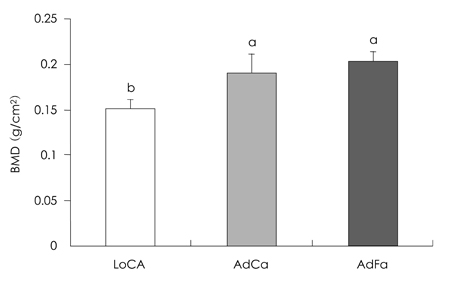Korean J Nutr.
2010 Aug;43(4):351-356. 10.4163/kjn.2010.43.4.351.
Effect of Calcium Source using Tilapia Mossambica Scales on the Bone Metabolic Biomarkers and Bone Mineral Density in Rats
- Affiliations
-
- 1Department of Food and Nutrition, Dong-Eui University, Busan 614-714, Korea. gayoon@deu.ac.kr
- 2Department of Life Science and Biotechnology, Dong-Eui University, Busan 614-714, Korea.
- KMID: 2268023
- DOI: http://doi.org/10.4163/kjn.2010.43.4.351
Abstract
- This study was done to evaluate the effect of Ca source using fish (Tilapia mossambica) scales on the bone metabolism. Male Sprague-Dawley rats, 4 weeks of age, were fed low-calcium diet (0.15% Ca) for 2 weeks. The rats on the low-calcium diet were further assigned to one of following three groups for an additional 4 weeks: 1) Ca-depletion group (LoCa) given 0.15% Ca diet (CaCO3), 2) Ca-repletion group (AdCa) given 0.5% Ca diet (CaCO3), 3) Ca-repletion diet (AdFa) received 0.5% Ca diet (Ca source from Tilapia mossambica scales). Serum parathyroid (PTH) and calcitonin showed no differences among experimental groups. Whereas LoCa group elevated the turnover markers, serum ALP and osteocalcin, and urinary deoxypyridinoline (DPD), AdCa and AdFa groups reduced their values. Elevation in the femoral weight, ash and Ca contents was observed in AdCa and AdFa groups. Bone mineral density was increased in AdCa and AdFa groups by 25-26% compared with LoCa group. These data demonstrate that Ca repletion with either Ca source from Tilapia mossambica scales or CaCO3 is similarly effective in the improvement of bone turnover markers and BMD, suggesting the usefulness of Tilapia mossambica scales in the prevention of bone loss compared with CaCO3.
MeSH Terms
Figure
Reference
-
1. Cummings SR, Rubin SM, Black D. The future of hip fractures in the United States: number, cost and potential effects of postmenopausal estrogen. Clin Orthop Relat Res. 1990. 252:163–166.2. Yoon GA, Hwang HJ. Effect of soy protein/animal protein ratio on calcium metabolism of the rat. Nutrition. 2006. 22:414–418.
Article3. Ministry of Health and Wellfare. 2005 National Nutrition Survey Report. 2006.4. Lee SH, Chang SO. Comparison of the bioavailability of calcium from anchovy, tofu and nonfat dry milk in growing male rats. Korean J Nutr. 1994. 27:473–482.5. Lee YS, Oh JH. Effects of bovine bone ash and calcium phosphate on calcium metabolism in postmenopausal osteoporosis model rats. Korean J Nutr. 1995. 28:434–441.6. Siebel M, Woitge HW. Biochemical markers of bone metabolism-update 1999. Clin Lab. 1999. 45:237–256.7. Hannon RA, Eastell R. Biochemical markers of bone turnover and fracture prediction. J Br Menopause Soc. 2003. 9:10–15.
Article8. Weisman SM, Matkovic V. Potential use of biochemical markers of bone turnover for assessing the effect of calcium supplementation and predicting fracture risk. Clin Therapeutics. 2005. 27:299–308.
Article9. Heaney RP, Dowell SD, Bierman J. Absorbability and cost effectiveness in calcium supplementation. J Am Coll Nutr. 2001. 20:239–246.
Article10. Bone Health and Osteoporosis: A surgeon General's Report. 2004. Washington DC: US Dept of Health and Human Service.11. Austin LA., Health H. Calcitonin: physiology and pathophysiology. N Eng J Med. 1981. 29:269–278.12. Aloia JF, Cohr SH, Vaswani A, Yeh JK, Yuen K, Ellis K. Risk factors for postmenopausal osteoporosis. Am J Med. 1985. 78:95–100.
Article13. Price PA, Pathermore JG, Doftos LJ. New biochemical marker for bone metabolism. J Clin Invest. 1980. 66:878–883.14. Delmas PD, Hardy P, Garnero P, Dain M. Monitoring individual response to hormone replacement therapy with bone marker. Bone. 2000. 26:553–560.
Article15. Foley MK. Influence of dietary calcium and cholecalciferol on composition of plasma lipids in young pig. J Nutr. 1990. 120:45–51.
Article16. Lee JH, Moon SJ, Huh GB. Influence of phytate and low dietary calcium on calcium, phosphate and zinc metabolism by growing rats. Korean J Nutr. 1993. 26:145–155.17. Han J, Kim E, Cheong M, Chee S, Chee K. Bioavailablity and digestibility of organic calcium source by bone health index. Korean J Nutr. 2010. 43:12–25.
Article18. Moon SJ, Kim JH, Lim SK. Investigation of risk of low serum 25-hydroxyvitamin D levels in Korean menopausal women. Korean J Nutr. 1996. 29:981–990.19. Kodama Y, Miyakoshi N, Linkhart TA, Wergedal J, Srivastava A, Beamer W, Donahue LR, Rosen C, Baylink DJ, Farley J. Effects of dietary calcium depletion and repletion on dynamic determinants of tibial bone volume in two inbred strains of mice. Bone. 2000. 27:445–452.
Article20. Shen V, Birchman R, Xu R, Lindsay R, Demster DW. Short-term changes in histomorphometric and biochemical turnover markers and bone mineral density in estrogen-and/or dietary calcium-deficient fats. Bone. 1995. 16:149–156.
Article21. Ohishi T, TakaHashi M, Kawana K, Aoshima H, Hoshino H. Age-related changes of urinary pyridinoline and deoxypyridinoline in Japanese subjects. Clin Invest Med. 1993. 16:319–325.22. Kim YM, Yoon GA, Hwang HJ, Chi GY, Son BY, Bae SY, Kim IY, Chung JY. Effect of bluefin tuna bone on calcium metabolism of the rats. J Korean Soc Food Sci Nutr. 2004. 33:101–106.23. Kato S, Mano T, Kobayashi T, Yamazaki H, Himeno Y, Yamamoto K, Itoh M, Harada N, Nagasaka A. A calcium-deficient diet caused decreased bone mineral density and secondary elevation of estrogen in aged male rats-Effect of manatetrenone and elcatonin. Metabolism. 2002. 51:1230–1234.
Article
- Full Text Links
- Actions
-
Cited
- CITED
-
- Close
- Share
- Similar articles
-
- The Effect of Dietary Protein Source and Sulfur Amino acid Content on bone Metabolism in Growing Rats
- Effect of Calcium and Activated Vitamin D ( 1- hydroxyvitamin-D ) on Bone Mineral Density in Osteoporosis
- Beneficial effect of fish oil on bone mineral density and biomarkers of bone metabolism in rats
- Effects of taurine supplementation on bone mineral density in ovariectomized rats fed calcium deficient diet
- Bone and Metabolic Markers in Women With Recurrent Calcium Stones


